Providing cannabis plants a good soil abundant in beneficial microbial life is the secret behind maximum performance organic growing. True Living Organics (TLO) is a method to foster beneficial fungi, bacteria, and microbes in the soil.
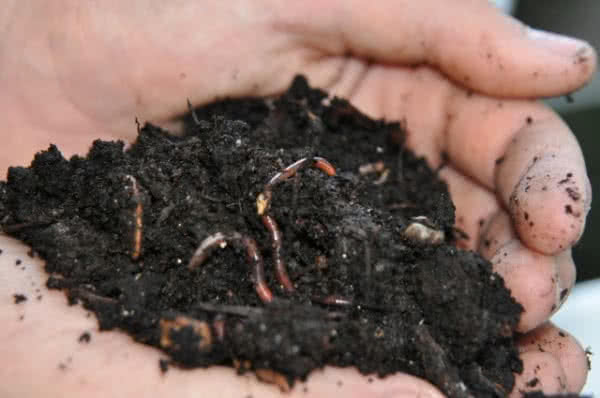
Nutrient Cycling in Nature
Organic matter that falls to the ground will decompose, enriching the soil structure and fostering microbial life.
This natural decomposition process is how plants thrive without human intervention. Their remains create food and habitat for the microscopic fungi, bacteria, and larger organisms, such as earthworms, to improve soil conditions now and for future generations.
When a tree drops its leaves, it can make a mulch to the same effect. This, in turn, optimizes the soil—even helping the tree grow stronger—so that its roots provide a home for the microbes to feed on. Most plants in the world already depend on this age-old process of working with microorganisms to obtain the nutrients required for growth from the soil.
Fungi and bacteria work together to break down organic material. For garden soil and potting mixes, speeding up the decomposition rate means that plants can quickly utilize nutrients from organic material.
Bone meal, blood meal, chicken manure, and nutrient-rich compost are all examples of organic matter that’s not readily available for plant absorption. Rather, they are slow-release fertilizers. Some of the nutrients are released and absorbed quickly, while others must be “mined” into smaller particles in order to be used by a plant.
Best way to speed up this process?
Just maximize the beneficial fungi and bacteria.
Decomposing organic matter is full of everything that fungi and bacteria need to establish themselves. Increasing the organic matter levels in your soil is an effective way to help plants absorb more nutrients from the soil.
Try this experiment in a local forest:
- During fair weather, find a thick pile of fallen leaf litter underneath a tree.
- Dig into the leaf pile until the topsoil level is reached. You may see white saprophytic fungi on leaves as you get deeper.
- Pull back the topsoil and take a look at the plant’s roots. If you see white fuzzy fungi growing directly on roots, then you’ve found mycorrhizal fungi, naturally occurring beneficial fungi that form on plant roots.
While most of what is covering leaf litter, mulch, and compost are actually Saprophytic fungi, the fungi that grow on plant roots are called Mycorrhizal Fungi, which help plants absorb nutrients.
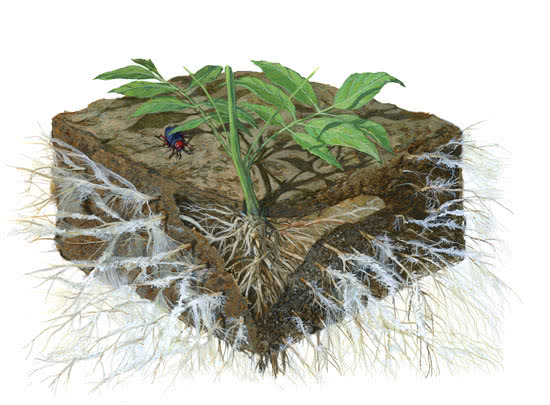
Beneficial Fungi
Mycorrhizal fungi have a symbiotic relationship with plants. What mycorrhizal fungi do is live as a host on your cannabis roots.
Why does it need a host? Because the roots contain much-needed carbohydrates for the fungi as well as a home.
So what do plants get in return? This beneficial fungus helps to feed the plant nutrients from the organic matter broken down in the soil. This plant-fungi association is to create a larger habitat for the fungi to live on—it’s a win-win situation for both the plants and fungi (in most circumstances).
While saprophytic fungi are the main decomposers of the fungal kingdom, mycorrhizal fungi are responsible, either directly or by association, for the creation of strong enzymes that break down dead material sources in the soil.
Benefits of mycorrhizal fungi plant associations include
- healthier plants
- quicker growth
- enhanced resistance to pests and diseases
- increased drought resistance
- reduced transplant shock
- higher yields
Creating an optimal soil environment for mycorrhizal fungi to flourish is the backbone of the True Living Organics method, which is based on this book written by the Rev.
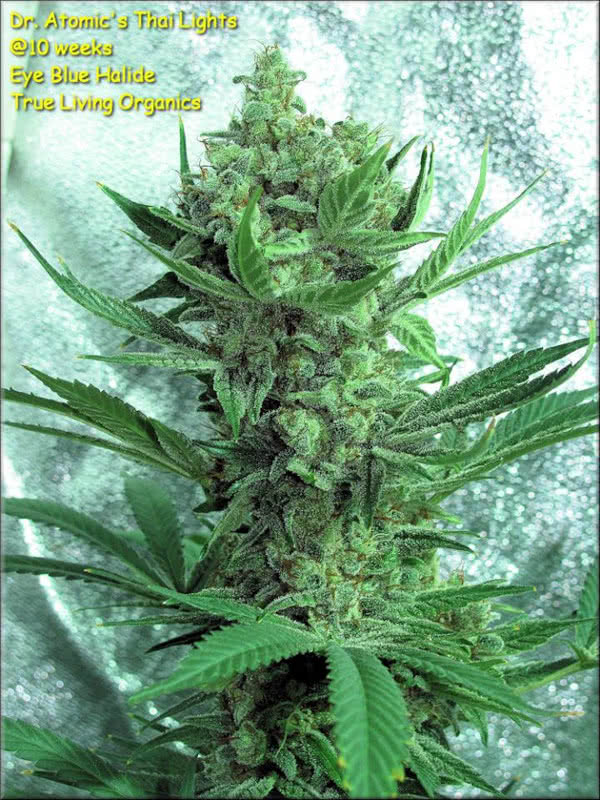
True Living Organic practices are not strictly for outdoor growing. Fungus and bacteria will still be doing their job indoors too 🙂
Organic Soil Mix Considerations
TLO Recipe – Instructions for building a TLO soil mix
Here is the TLO organic soil mix recipe we have used for years with great results—http://greenthumbgirlsblog.blogspot.com/2013/09/recipe-rev-21-soil-i-made.html
You can find all the materials for sale at local garden shops, online at Amazon, and other retailers.
Note that mycorrhizal fungi are extremely delicate; they can be wiped out easily. Be careful not to use any salt-based fertilizers such as synthetic chemical fertilizers. Adding salt to fungus will simply dehydrate it, similar to putting table salt on a slug.
Well-aerated soil is the key to success in the True Living Organic growing method. Make sure your soil has a wealth of aeration. TLO mixes generally consist of ¼ perlite. Using perlite in the soil is basically like having a bunch of artificial air pockets throughout your mix. Microbial life needs to breathe and flourish in highly aerated environments, taking advantage of all those air pockets.
Coco coir is also well aerated and retains 10 times its dry weight in water. Be sure to rinse the coco coir out thoroughly: soak the bricks in a tub and drain the water out 2 or 3 times to get any salts out. Coco coir being a coconut product, more often than not, contains salt.
Compost teas are extremely effective when done right, creating a microbial life explosion in the soil. Be sure to aerate compost teas; otherwise, you could be harming the beneficial microbes instead of helping them. Read a compost tea how-to article here—http://www.finegardening.com/brewing-compost-tea.
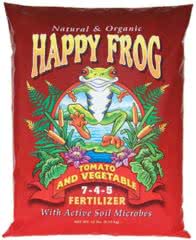 FoxFarm’s Happy Frog fertilizer comes loaded with beneficial microbes such as mycorrhizal fungi as well as bat guano, kelp meal, alfalfa meal, fish meal, and humic acid. A safe bet for True Living Organics soils, this cocktail of organic fertilizers is ideal for your plant and soil health. Happy Frog fertilizer is slow-release and can be applied by mixing directly into your soil, sprinkling onto the topsoil, or making spikes (probe a hole into the root zone soil and fill it with the fertilizer). Happy Frog is a genuine wonder product for organic growers.
FoxFarm’s Happy Frog fertilizer comes loaded with beneficial microbes such as mycorrhizal fungi as well as bat guano, kelp meal, alfalfa meal, fish meal, and humic acid. A safe bet for True Living Organics soils, this cocktail of organic fertilizers is ideal for your plant and soil health. Happy Frog fertilizer is slow-release and can be applied by mixing directly into your soil, sprinkling onto the topsoil, or making spikes (probe a hole into the root zone soil and fill it with the fertilizer). Happy Frog is a genuine wonder product for organic growers.
For information about building an optimal soil-mix maximizing mycorrhizal fungi, check out SKUNK magazine & the Rev.
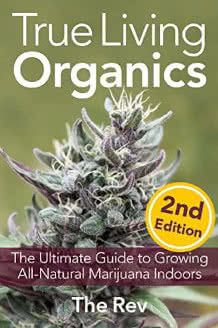 The Rev’s book True Living Organics: The Ultimate Guide to Growing All-Natural Marijuana Indoors is essential reading for the organic grower, and certainly not just indoor growers. The Rev explains the delicate symphony of soil micro life in an easy-to-read format suitable for growers of all skill levels. You will learn how to create healthy microbe-friendly soils and hear the dangers of what to look out for. Worm farms, organic tea mixes, and soil amendments are all covered in depth. The book also contains detailed instructions on creating your own TLO soil mix—complete with a wide variety of nutrient sources. Part of this system focuses on pumping up the aeration of your soil in order to create a better habitat for mycorrhizal fungi. Fungi need air to grow and will flourish in properly aerated soil.
The Rev’s book True Living Organics: The Ultimate Guide to Growing All-Natural Marijuana Indoors is essential reading for the organic grower, and certainly not just indoor growers. The Rev explains the delicate symphony of soil micro life in an easy-to-read format suitable for growers of all skill levels. You will learn how to create healthy microbe-friendly soils and hear the dangers of what to look out for. Worm farms, organic tea mixes, and soil amendments are all covered in depth. The book also contains detailed instructions on creating your own TLO soil mix—complete with a wide variety of nutrient sources. Part of this system focuses on pumping up the aeration of your soil in order to create a better habitat for mycorrhizal fungi. Fungi need air to grow and will flourish in properly aerated soil.
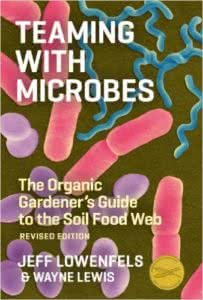
For those interested in the science of True Living Organics, you should pick up Teaming with Microbes: The Organic Gardener’s Guide to the Soil Food Web. Written in an entertaining style, this book explains the fundamentals of microorganisms in your soil and how they can benefit your plants. It also explains why chemical fertilizers are detrimental to soil health, injuring the soil food web’s microbial life. You will learn about the science behind why feeding your soil will, in turn, feed your plant and how pumping up your micro-life will increase your plants’ performance and nutrient availability.
Read next: [USA] Before You Buy Pot Seeds


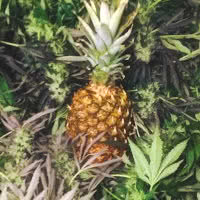
Very informative article.Much thanks again. Much obliged.
Ho brah, you like! Mahalo!
I really like and appreciate your article post. Will read on… Farah
Thank you and Mahalos
Thank’s great post.
Awesome site! I am from upper Puna, and find all the wet growing information indispensable. Mahalo
Thanks for the good vibes Pertodrvrr, hope you’re doing well out there.
That Thai Lights looks deadly potent…. need some!
Thai cannabis sativa is some of the most psychedelic head highs there is… The kind of weed you smoke and feel paranoid about everything you are doing, constantly reevaluating you actions. Toking on this herb can be fun and exciting for some, while others it is mentally tiring, and often too much of an effect. The high lasts for hours…